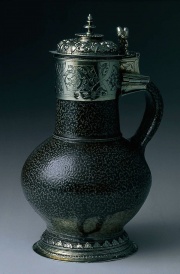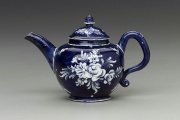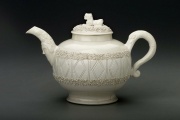Difference between revisions of "Salt glaze"
(username removed) |
(username removed) |
||
| Line 2: | Line 2: | ||
== Description == | == Description == | ||
| − | A glassy [http://cameo.mfa.org/materials/fullrecord.asp?name=ceramic | + | A glassy [http://cameo.mfa.org/materials/fullrecord.asp?name=ceramic%20glaze ceramic glaze] with a pebbly texture. First made as early as the 12th century in Holland and Germany, salt glazes are produced by a vapor-phase formation of [http://cameo.mfa.org/materials/fullrecord.asp?name=sodium%20silicate sodium silicate] on the clay surface. An unglazed vessel is placed in the kiln and heated to the optimum temperature (about 1200-1250C), then common salt ([http://cameo.mfa.org/materials/fullrecord.asp?name=sodium%20chloride sodium chloride]) is thrown into the fire. The salt vaporizes and reacts with steam to produce [http://cameo.mfa.org/materials/fullrecord.asp?name=sodium%20oxide sodium oxide] which then reacts with the [http://cameo.mfa.org/materials/fullrecord.asp?name=silica silica] in the clay body to form sodium silicate. Salt glazes are very hard and durable. They have been used on stoneware crocks, masonry units, and terracotta sewer pipes. |
[[File:1997.168a-b-SC8985.jpg|thumb|]] | [[File:1997.168a-b-SC8985.jpg|thumb|]] | ||
== Synonyms and Related Terms == | == Synonyms and Related Terms == | ||
| − | salt-glaze; demi- | + | salt-glaze; demi-émaillage (Fr.); vidrado salino (Port.) |
== Other Properties == | == Other Properties == | ||
| − | Colors can be produced by adding [http://cameo.mfa.org/materials/fullrecord.asp?name=iron | + | Colors can be produced by adding [http://cameo.mfa.org/materials/fullrecord.asp?name=iron%20oxide%20red iron oxide] (brown), [http://cameo.mfa.org/materials/fullrecord.asp?name=cobalt%20oxide cobalt oxide] (blue), or [http://cameo.mfa.org/materials/fullrecord.asp?name=manganese%20oxide manganese oxide] (purple). |
== Hazards and Safety == | == Hazards and Safety == | ||
| − | [http://cameo.mfa.org/materials/fullrecord.asp?name=Hydrochloric | + | [http://cameo.mfa.org/materials/fullrecord.asp?name=Hydrochloric%20acid Hydrochloric acid] is a by-product of the reaction. |
[[File:95.279a-b-SC9111.jpg|thumb|]] | [[File:95.279a-b-SC9111.jpg|thumb|]] | ||
| Line 24: | Line 24: | ||
== Authority == | == Authority == | ||
| − | * | + | * Ralph Mayer, ''A Dictionary of Art Terms and Techniques'', Harper and Row Publishers, New York, 1969 (also 1945 printing) |
* ''Dictionary of Building Preservation'', Ward Bucher, ed., John Wiley & Sons, Inc., New York City, 1996 | * ''Dictionary of Building Preservation'', Ward Bucher, ed., John Wiley & Sons, Inc., New York City, 1996 | ||
| − | * | + | * Henry Hodges, ''Artifacts: An Introduction to Early Materials and Technology'', Ronald P. Frye, Kingston, Canada, 1988 |
| − | * | + | * Robert Fournier, ''Illustrated Dictionary of Practical Pottery'', Chilton Book Company, Radnor, PA, 1992 |
| − | * ''Encyclopedia Britannica'', http://www.britannica.com Comment: "salt glaze." | + | * ''Encyclopedia Britannica'', http://www.britannica.com Comment: "salt glaze." Encyclopædia Britannica. 2005. Encyclopædia Britannica Premium Service 4 Feb. 2005 . |
* Art and Architecture Thesaurus Online, http://www.getty.edu/research/tools/vocabulary/aat/, J. Paul Getty Trust, Los Angeles, 2000 | * Art and Architecture Thesaurus Online, http://www.getty.edu/research/tools/vocabulary/aat/, J. Paul Getty Trust, Los Angeles, 2000 | ||
Revision as of 06:39, 24 July 2013
Description
A glassy ceramic glaze with a pebbly texture. First made as early as the 12th century in Holland and Germany, salt glazes are produced by a vapor-phase formation of sodium silicate on the clay surface. An unglazed vessel is placed in the kiln and heated to the optimum temperature (about 1200-1250C), then common salt (sodium chloride) is thrown into the fire. The salt vaporizes and reacts with steam to produce sodium oxide which then reacts with the silica in the clay body to form sodium silicate. Salt glazes are very hard and durable. They have been used on stoneware crocks, masonry units, and terracotta sewer pipes.
Synonyms and Related Terms
salt-glaze; demi-émaillage (Fr.); vidrado salino (Port.)
Other Properties
Colors can be produced by adding iron oxide (brown), cobalt oxide (blue), or manganese oxide (purple).
Hazards and Safety
Hydrochloric acid is a by-product of the reaction.
Additional Information
R.Fournier, Illustrated Dictionary of Practical Pottery, Chilton Book Company, Radnor, PA, 1996.
Authority
- Ralph Mayer, A Dictionary of Art Terms and Techniques, Harper and Row Publishers, New York, 1969 (also 1945 printing)
- Dictionary of Building Preservation, Ward Bucher, ed., John Wiley & Sons, Inc., New York City, 1996
- Henry Hodges, Artifacts: An Introduction to Early Materials and Technology, Ronald P. Frye, Kingston, Canada, 1988
- Robert Fournier, Illustrated Dictionary of Practical Pottery, Chilton Book Company, Radnor, PA, 1992
- Encyclopedia Britannica, http://www.britannica.com Comment: "salt glaze." Encyclopædia Britannica. 2005. Encyclopædia Britannica Premium Service 4 Feb. 2005 .
- Art and Architecture Thesaurus Online, http://www.getty.edu/research/tools/vocabulary/aat/, J. Paul Getty Trust, Los Angeles, 2000


